Description
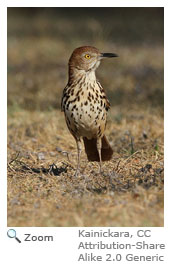 The Brown Thrasher is a gangly songbird. Its long, sturdy legs hold up its large, slender body. The Brown Thrasher has a brown head, back, wings and tail with heavy brown streaking on its white chest and belly. Its eyes are bright yellow. The Brown Thrasher is an exuberant and varied singer. The Brown Thrasher is a gangly songbird. Its long, sturdy legs hold up its large, slender body. The Brown Thrasher has a brown head, back, wings and tail with heavy brown streaking on its white chest and belly. Its eyes are bright yellow. The Brown Thrasher is an exuberant and varied singer.
Range
The Brown Thrasher can be found throughout eastern North America. In the summer, the Brown Thrasher breeds from south-central Canada to New England, throughout the Midwest and along the East Coast. Year-round, the Brown Thrasher lives in the southeastern United States.
Habitat
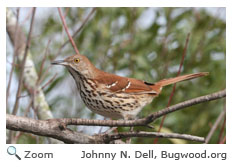 In eastern North America, the Brown Thrasher nests along forest edges, thickets and overgrown clearings in hardwood forests. In the Midwest, it breeds in fencerows, sheltered areas and woody areas. In eastern North America, the Brown Thrasher nests along forest edges, thickets and overgrown clearings in hardwood forests. In the Midwest, it breeds in fencerows, sheltered areas and woody areas. |
|
Diet
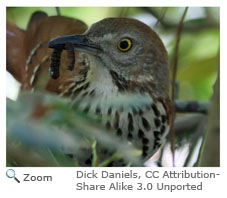 Eating insects, fruit, seeds and nuts, the Brown Thrasher is an omnivore. It feeds mostly on the ground, sweeping its bill along the ground to gather insects. The Brown Thrasher eats fruit right off the berry bush and gathers seeds directly from the plant. It eats a variety of insects, including beetles, cutworms, tent caterpillars, spongy moth caterpillars, leafhoppers, crickets, wasps and bees. Eating insects, fruit, seeds and nuts, the Brown Thrasher is an omnivore. It feeds mostly on the ground, sweeping its bill along the ground to gather insects. The Brown Thrasher eats fruit right off the berry bush and gathers seeds directly from the plant. It eats a variety of insects, including beetles, cutworms, tent caterpillars, spongy moth caterpillars, leafhoppers, crickets, wasps and bees.
Life Cycle
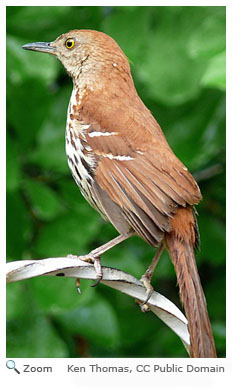 The male and female Brown Thrasher build the cup-shaped nest together from twigs, dead leaves, bark, grass and rootlets. The nest is usually built low in a tree or thorny shrub such as forsythia, gooseberry, sumac or multiflora rose. The male and female Brown Thrasher build the cup-shaped nest together from twigs, dead leaves, bark, grass and rootlets. The nest is usually built low in a tree or thorny shrub such as forsythia, gooseberry, sumac or multiflora rose.
The female lays 2-6 blue or white eggs. She incubates the eggs for 10-14 days. After hatching, chicks remain in the nest for nearly two weeks before fledging.
Behavior
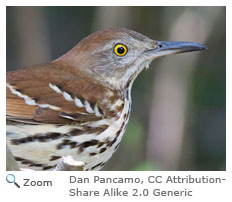 The Brown Thrasher sings a wide variety of songs. Scientists think it can sing more than 1,100 different song types! It is known to imitate other birds, including Wood Thrushes, Northern Flickers and Chuck-will's-widows. The Brown Thrasher sings a wide variety of songs. Scientists think it can sing more than 1,100 different song types! It is known to imitate other birds, including Wood Thrushes, Northern Flickers and Chuck-will's-widows. |





